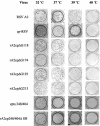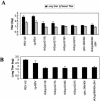Recombinant respiratory syncytial viruses lacking the C-terminal third of the attachment (G) protein are immunogenic and attenuated in vivo and in vitro
- PMID: 15140975
- PMCID: PMC415824
- DOI: 10.1128/JVI.78.11.5773-5783.2004
Recombinant respiratory syncytial viruses lacking the C-terminal third of the attachment (G) protein are immunogenic and attenuated in vivo and in vitro
Abstract
The design of attenuated vaccines for respiratory syncytial virus (RSV) historically focused on viruses made sensitive to physiologic temperature through point mutations in the genome. These prototype vaccines were not suitable for human infants primarily because of insufficient attenuation, genetic instability, and reversion to a less-attenuated phenotype. We therefore sought to construct novel attenuated viruses with less potential for reversion through genetic alteration of the attachment G protein. Complete deletion of G protein was previously shown to result in RSV strains overly attenuated for replication in mice. Using reverse genetics, recombinant RSV (rRSV) strains were engineered with truncations at amino acid 118, 174, 193, or 213 and respectively designated rA2cpDeltaG118, rA2cpDeltaG174, rA2cpDeltaG193, and rA2cpDeltaG213. All rA2cpDeltaG strains were attenuated for growth in vitro and in the respiratory tracts of BALB/c mice but not restricted for growth at 37 degrees C. The mutations did not significantly affect nascent genome synthesis in human lung epithelial (A549) cells, but infectious rA2cpDeltaG virus shed into the culture medium was dramatically diminished. Hence, the data suggested that a site within the C-terminal 85 amino acids of G protein is important for efficient genome packaging or budding of RSV from the infected cell. Vaccination with the rA2cpDeltaG strains also generated efficacious immune responses in mice that were similar to those elicited by the temperature-sensitive cpts248/404 strain previously tested in human infants. Collectively, the data indicate that the rA2cpDeltaG strains are immunogenic, not likely to revert to the less-attenuated phenotype, and thus candidates for further development as vaccines against RSV.
Figures





Similar articles
-
Characterization of recombinant respiratory syncytial viruses with the region responsible for type 2 T-cell responses and pulmonary eosinophilia deleted from the attachment (G) protein.J Virol. 2004 Aug;78(16):8446-54. doi: 10.1128/JVI.78.16.8446-8454.2004. J Virol. 2004. PMID: 15280453 Free PMC article.
-
Alphavirus replicon particles encoding the fusion or attachment glycoproteins of respiratory syncytial virus elicit protective immune responses in BALB/c mice and functional serum antibodies in rhesus macaques.Vaccine. 2007 Oct 10;25(41):7132-44. doi: 10.1016/j.vaccine.2007.07.065. Epub 2007 Aug 21. Vaccine. 2007. PMID: 17850933
-
Immune responses to the nonglycosylated ectodomain of respiratory syncytial virus attachment glycoprotein mediate pulmonary eosinophilia in inbred strains of mice with different MHC haplotypes.J Med Virol. 2003 Jun;70(2):301-8. doi: 10.1002/jmv.10395. J Med Virol. 2003. PMID: 12696122
-
Immunopathology of RSV infection: prospects for developing vaccines without this complication.Rev Med Virol. 2007 Jan-Feb;17(1):5-34. doi: 10.1002/rmv.518. Rev Med Virol. 2007. PMID: 17004293 Review.
-
Evaluation of the Safety and Immune Efficacy of Recombinant Human Respiratory Syncytial Virus Strain Long Live Attenuated Vaccine Candidates.Virol Sin. 2021 Aug;36(4):706-720. doi: 10.1007/s12250-021-00345-3. Epub 2021 Feb 9. Virol Sin. 2021. PMID: 33559831 Free PMC article. Review.
Cited by
-
Characterization of recombinant respiratory syncytial viruses with the region responsible for type 2 T-cell responses and pulmonary eosinophilia deleted from the attachment (G) protein.J Virol. 2004 Aug;78(16):8446-54. doi: 10.1128/JVI.78.16.8446-8454.2004. J Virol. 2004. PMID: 15280453 Free PMC article.
-
Sendai virus as a backbone for vaccines against RSV and other human paramyxoviruses.Expert Rev Vaccines. 2016;15(2):189-200. doi: 10.1586/14760584.2016.1114418. Epub 2015 Dec 9. Expert Rev Vaccines. 2016. PMID: 26648515 Free PMC article. Review.
-
Development of an Improved Epstein-Barr Virus (EBV) Neutralizing Antibody Assay to Facilitate Development of a Prophylactic gp350-Subunit EBV Vaccine.Mediterr J Hematol Infect Dis. 2020 Mar 1;12(1):e2020016. doi: 10.4084/MJHID.2020.016. eCollection 2020. Mediterr J Hematol Infect Dis. 2020. PMID: 32180911 Free PMC article.
-
Respiratory syncytial virus (RSV) fusion protein expressed by recombinant Sendai virus elicits B-cell and T-cell responses in cotton rats and confers protection against RSV subtypes A and B.Vaccine. 2007 Dec 17;25(52):8782-93. doi: 10.1016/j.vaccine.2007.10.038. Epub 2007 Nov 5. Vaccine. 2007. PMID: 18037543 Free PMC article.
References
-
- Bukreyev, A., S. S. Whitehead, B. R. Murphy, and P. L. Collins. 1997. Recombinant respiratory syncytial virus from which the entire SH gene has been deleted grows efficiently in cell culture and exhibits site-specific attenuation in the respiratory tract of the mouse. J. Virol. 71:8973-8982. - PMC - PubMed
-
- Choi, E. H., and H. J. Lee. 2000. Genetic diversity and molecular epidemiology of the G protein of subgroups A and B of respiratory syncytial viruses isolated over 9 consecutive epidemics in Korea. J. Infect. Dis. 181:1547-1556. - PubMed
-
- Collins, P., M. Hill, E. Camargo, H. Grosfeld, R. Chanock, and B. Murphy. 1995. Production of infectious human respiratory syncytial virus from cloned cDNA confirms an essential role for the transcription elongation factor from the 5′ proximal open reading frame of the M2 mRNA in gene expression and provides a capability for vaccine development. Proc. Natl. Acad. Sci. USA 92:11563-11567. - PMC - PubMed
MeSH terms
Substances
LinkOut - more resources
Full Text Sources
Other Literature Sources

